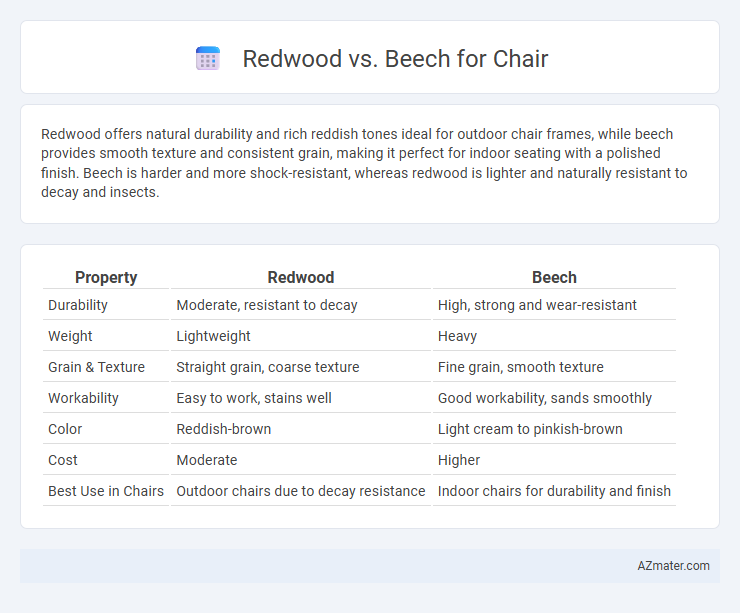Redwood offers natural durability and rich reddish tones ideal for outdoor chair frames, while beech provides smooth texture and consistent grain, making it perfect for indoor seating with a polished finish. Beech is harder and more shock-resistant, whereas redwood is lighter and naturally resistant to decay and insects.
Table of Comparison
| Property | Redwood | Beech |
|---|---|---|
| Durability | Moderate, resistant to decay | High, strong and wear-resistant |
| Weight | Lightweight | Heavy |
| Grain & Texture | Straight grain, coarse texture | Fine grain, smooth texture |
| Workability | Easy to work, stains well | Good workability, sands smoothly |
| Color | Reddish-brown | Light cream to pinkish-brown |
| Cost | Moderate | Higher |
| Best Use in Chairs | Outdoor chairs due to decay resistance | Indoor chairs for durability and finish |
Introduction to Redwood and Beech Woods
Redwood, known for its rich reddish hue and natural resistance to decay, offers exceptional durability and a smooth finish ideal for crafting chairs designed to last. Beech wood, characterized by its pale cream color and fine grain, provides strength and a satiny texture that enhances comfort and aesthetics in chair making. Both woods are favored for their workability and have distinct benefits, with redwood excelling in outdoor durability and beech prized for its indoor furniture elegance.
Botanical Overview: Redwood vs Beech
Redwood, scientifically known as Sequoia sempervirens, is a tall evergreen conifer with naturally rot-resistant, reddish-brown wood prized for outdoor furniture due to its durability and stability. Beech, or Fagus sylvatica, is a deciduous hardwood native to Europe, featuring dense, pale cream-colored wood with a fine, uniform texture ideal for indoor chairs that require smooth, durable surfaces. The botanical difference lies in Redwood's softwood classification with a fibrous grain structure versus Beech's hardwood status with a tight, fine grain, impacting both aesthetic qualities and functional performance in chair making.
Physical Properties and Appearance Comparison
Redwood features a reddish-brown hue with a straight, coarse grain, making it visually warm and rustic, while Beech exhibits a pale cream color with a fine, tight grain, offering a smooth and uniform appearance ideal for polished finishes. Redwood's density ranges from 350 to 510 kg/m3, providing moderate strength and natural resistance to decay, whereas Beech is harder and denser, around 720 kg/m3, lending itself to greater durability and resistance to wear. The softer nature of Redwood allows easier shaping and carving, contrasted by Beech's rigidity, which supports structural integrity and longevity in chair construction.
Strength and Durability: Which Lasts Longer?
Redwood offers impressive natural resistance to decay and insects, making it highly durable for chair construction, especially in outdoor settings. Beech wood, known for its dense, hard grain, provides excellent strength and wear resistance, ideal for indoor furniture that undergoes daily use. While Beech generally outlasts Redwood indoors due to its hardness, Redwood's longevity excels in outdoor environments where moisture and pests pose challenges.
Workability and Craftsmanship Suitability
Redwood offers excellent workability due to its soft texture and straight grain, making it easy to shape and carve for detailed chair designs. Beech is highly valued for its fine, tight grain and hardness, providing superior durability and a smooth finish ideal for intricate joinery and polished craftsmanship. While Redwood excels in ease of manipulation, Beech is preferred for furniture that demands structural strength and long-lasting refinement.
Comfort and Ergonomics in Chair Design
Redwood offers a lightweight yet sturdy frame ideal for ergonomic chair design, providing natural cushioning that enhances comfort during extended use. Beech wood's dense grain structure contributes to durability and support, allowing for expertly contoured seating that promotes proper posture. Chairs crafted from beech often feature precise shaping capabilities, ensuring optimal lumbar support and reducing user fatigue.
Cost and Availability Analysis
Redwood chairs generally cost more due to the wood's natural durability and resistance to decay, making it a premium choice for outdoor and rustic furniture. Beech, being a hardwood commonly found in Europe and North America, offers a more budget-friendly option with greater availability in local markets and faster replenishment rates. While Redwood can command higher prices in specialty stores, Beech benefits from widespread supply chains, reducing lead times and overall investment for chair production.
Environmental Impact and Sustainability
Redwood offers significant sustainability benefits due to its rapid growth rate, carbon sequestration capabilities, and prevalence in managed forests that promote reforestation. Beech, while durable and widely used in furniture making, often involves slower-growing trees, which can lead to higher environmental impacts if not sourced responsibly from sustainably managed forests. Choosing Redwood for chairs typically reduces ecological footprint through sustainable harvesting practices and long-term forest health maintenance.
Maintenance and Longevity of Finished Chairs
Redwood chairs require less maintenance due to their natural resistance to decay and insect damage, making them ideal for outdoor use. Beech chairs, while offering a smooth finish and excellent strength, need regular sealing or varnishing to protect against moisture and wear. Over time, finished redwood chairs tend to maintain their structural integrity longer with minimal upkeep, whereas beech chairs may require more frequent refinishing to preserve appearance and durability.
Conclusion: Choosing the Right Wood for Your Chair
Redwood offers durability and natural resistance to decay, making it ideal for outdoor or high-moisture environments, while beech provides a smooth, fine grain perfect for indoor furniture with a polished finish. Beech's dense hardwood structure ensures excellent strength and shock resistance, suitable for chairs requiring robust support. Selecting between redwood and beech depends on the chair's intended use, desired aesthetics, and environmental exposure.

Infographic: Redwood vs Beech for Chair
 azmater.com
azmater.com